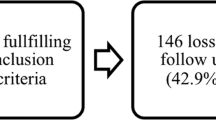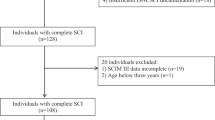Abstract
Background
Traumatic spinal cord injuries (TSCI) are associated with uncertainty regarding the prognosis of functional recovery. The aim of the present study was to evaluate the potential of early clinical variables to predict the degree of functional independence assessed by Spinal Cord Independence Measure III (SCIM-III) up to 1 year after injury.
Methods
Prospectively collected data from 143 SCI patients treated in Western Denmark during 2012–2019 were retrospectively analysed. Data analysis involved univariate methods and multivariable linear regression modelling total SCIM-III scores against age, gender, body mass index (BMI), comorbidity, American Spinal Injury Association (ASIA) Impairment Scale (AIS) grades A–B and C–D, ASIA Motor Score (AMS), timing of surgical treatment and occurrence of medical complications. Statistical significance was set at p < .05.
Results
Univariate analyses indicated that variables significantly associated with decreased functional independence included increased age (p = .023), increased BMI (p = .012), pre-existing comorbidity (p = .001), AIS grades A–B (p < .001), decreased AMS (p < .001) and occurrence of medical complications (p < .001). However, in the multivariable regression model were pre-existing comorbidity (p = .010), AIS grades A–B (p < .001), low AMS (p < .001) and late surgical treatment (p = .018) significant predictors of decreased functional independence 1 year after injury.
Conclusion
TSCI patients with greatest potential for functional recovery up to 1 year after injury seem to be patients that immediately after trauma present with few or no comorbidities, who sustain motor-incomplete injuries and undergo early decompressive surgery.
Similar content being viewed by others
Abbreviations
- ADL:
-
Activities of daily living
- ASIA:
-
American Spinal Injury Association
- AIS:
-
American Spinal Injury Association Impairment Scale
- AMS:
-
American Spinal Injury Association Motor Score
- ALT:
-
American Spinal Injury Association Sensory Score for Light Touch
- BMI:
-
Body mass index
- CI:
-
Confidence intervals
- Coef:
-
Coefficient
- ISNCSCI:
-
International Standards for Neurological Classification of Spinal Cord Injury
- IQR:
-
Interquartile range
- R 2 :
-
Adjusted R-square
- SCIM-III:
-
Spinal Cord Independence Measure III
- TSCI:
-
Traumatic spinal cord injury
References
Aarabi B, Sansur CA, Ibrahimi DM, Simard JM, Hersh DS, Le E, Diaz C, Massetti J, Akhtar-Danesh N (2017) Intramedullary lesion length on postoperative magnetic resonance imaging is a strong predictor of ASIA impairment scale grade conversion following decompressive surgery in cervical spinal cord injury. Clin Neurosurg 80(4):610–620
Anderson KIMD (2004) Targeting recovery: priorities of the spinal cord-injured population. J Neurotrauma 21(10):1371–1383
Brienza D, Krishnan S, Karg P, Sowa G, Allegretti AL (2018) Predictors of pressure ulcer incidence following traumatic spinal cord injury: a secondary analysis of a prospective longitudinal study. Spinal Cord 56(1):28–34
Denis AR, Feldman D, Thompson C, Mac-Thiong JM (2018) Prediction of functional recovery six months following traumatic spinal cord injury during acute care hospitalization. J Spinal Cord Med 41(3):309–317
Dickson HG, Catz A, Tamir A, Itzkovich M (1998) SCIM - Spinal Cord Independence Measure: a new disability scale for patients with spinal cord lesions (multiple letters) [1]. Spinal Cord 36(10):734–735
Facchinello Y, Beauséjour M, Richard-Denis A, Thompson C, Mac-Thiong J-M (2017) The use of regression tree analysis for predicting the functional outcome following traumatic spinal cord injury. J Neurotrauma. https://doi.org/10.1089/neu.2017.5321
Farhadi HF, Kukreja S, Minnema A, Vatti L, Gopinath M, Prevedello L, Chen C, Xiang H, Schwab JM (2018) Impact of admission imaging findings on neurological outcomes in acute cervical traumatic spinal cord injury. J Neurotrauma 35(12):1398–1406
Fehlings MG, Vaccaro A, Wilson JR et al (2012) Early versus delayed decompression for traumatic cervical spinal cord injury: results of the surgical timing in acute spinal cord injury study (STASCIS). PLoS One. https://doi.org/10.1371/journal.pone.0032037
Franceschini M, Bonavita J, Cecconi L, Ferro S, Pagliacci MC (2020) Traumatic spinal cord injury in Italy 20 years later: current epidemiological trend and early predictors of rehabilitation outcome. Spinal Cord. https://doi.org/10.1038/s41393-020-0421-y
Geuther M, Grassner L, Mach O et al (2019) Functional outcome after traumatic cervical spinal cord injury is superior in adolescents compared to adults. Eur J Paediatr Neurol 23(2):248–253
Grant SW, Hickey GL, Head SJ (2019) Statistical primer: multivariable regression considerations and pitfalls. Eur J Cardiothorac Surg 55(2):179–185
Grassner L, Wutte C, Klein B et al (2016) Early decompression (< 8 h) after traumatic cervical spinal cord injury improves functional outcome as assessed by spinal cord independence measure after one year. J Neurotrauma 33(18):1658–1666
Haldrup M, Dyrskog S, Thygesen MM, Kirkegaard H, Kasch H, Rasmussen MM (2020) Initial blood pressure is important for long-term outcome after traumatic spinal cord injury. J Neurosurg Spine:1–5
Haldrup M, Schwartz OS, Kasch H, Rasmussen MM (2019) Early decompressive surgery in patients with traumatic spinal cord injury improves neurological outcome. Acta Neurochir 161(10):2223–2228
Heinze G, Dunkler D (2017) Five myths about variable selection. Transpl Int 30(1):6–10
Horn SD, Smout RJ, Dejong G, Dijkers MP, Hsieh CH, Lammertse D, Whiteneck GG (2013) Association of various comorbidity measures with spinal cord injury rehabilitation outcomes. Arch Phys Med Rehabil 94(4 SUPPL):S75–S86
Itzkovich M, Gelernter I, Biering-Sorensen F et al (2007) The Spinal Cord Independence Measure (SCIM) version III: reliability and validity in a multi-center international study. Disabil Rehabil 29(24):1926–1933
Jaja BNR, Jiang F, Badhiwala JH et al (2019) Association of pneumonia, wound infection, and sepsis with clinical outcomes after acute traumatic spinal cord injury. J Neurotrauma 36(21):3044–3050
Jiang F, Jaja BNR, Kurpad SN et al (2019) Acute adverse events after spinal cord injury and their relationship to long-term neurologic and functional outcomes: analysis from the North American Clinical Trials Network for Spinal Cord Injury. Crit Care Med 47(11):e854–e862
Kaminski L, Cordemans V, Cernat E, M’Bra KI, Mac-Thiong JM (2017) Functional outcome prediction after traumatic spinal cord injury based on acute clinical factors. J Neurotrauma 34(12):2027–2033
Kramer JLK, Geisler F, Ramer L, Plunet W, Cragg JJ (2017) Open access platforms in spinal cord injury: existing clinical trial data to predict and improve outcomes. Neurorehabil Neural Repair 31(5):399–401
Kwon BK, Streijger F, Fallah N et al (2017) Cerebrospinal fluid biomarkers to stratify injury severity and predict outcome in human traumatic spinal cord injury. J Neurotrauma 34(3):567–580
Ozelie R, Gassaway J, Buchman E et al (2012) Relationship of occupational therapy inpatient rehabilitation interventions and patient characteristics to outcomes following spinal cord injury: the SCIRehab Project. J Spinal Cord Med 35(6):527–546
Pouw MH, Hosman AJF, Van Kampen A, Hirschfeld S, Thietje R, Van De Meent H (2011) Is the outcome in acute spinal cord ischaemia different from that in traumatic spinal cord injury? A cross-sectional analysis of the neurological and functional outcome in a cohort of 93 paraplegics. Spinal Cord 49(2):307–312
Rabinstein AA (2018) Traumatic spinal cord injury. Continuum (Minneap Minn) 24(2):551–566
Richard-Denis A, Beauséjour M, Thompson C, Nguyen BH, Mac-Thiong JM (2018) Early predictors of global functional outcome after traumatic spinal cord injury: a systematic review. J Neurotrauma 35(15):1705–1725
Richard Denis A, Thompson C, Mac Thiong J-M (2017) Determining complete functional independence in patients with a traumatic cervical spinal cord injury: proposal of a two-level scale based on the Spinal Cord Independence Measure. Int J Phys Med Rehabil 05(04):5–9
Roberts TT, Leonard GR, Cepela DJ (2017) Classifications in brief: American Spinal Injury Association (ASIA) Impairment Scale. Clin Orthop Relat Res 475(5):1499–1504
Teeter L, Gassaway J, Taylor S et al (2012) Relationship of physical therapy inpatient rehabilitation interventions and patient characteristics to outcomes following spinal cord injury: the SCIRehab Project. J Spinal Cord Med 35(6):503–526
Warner FM, Tong B, Jutzeler CR, Cragg JJ, Scheuren PS, Kramer JLK (2017) Long-term functional outcome in patients with acquired infections after acute spinal cord injury. Neurology 89(7):e76–e78
Wartenberg KE, Hwang DY, Haeusler KG et al (2019) Gap analysis regarding prognostication in neurocritical care: a joint statement from the German Neurocritical Care Society and the Neurocritical Care Society. Neurocrit Care 31(2):231–244
Whiteneck G, Gassaway J, Dijkers MP, Heinemann AW, Kreider SED (2012) Relationship of patient characteristics and rehabilitation services to outcomes following spinal cord injury: the SCIRehab Project. J Spinal Cord Med 35(6):484–502
Wilson JR, Davis AM, Kulkarni AV, Kiss A, Frankowski RF, Grossman RG, Fehlings MG (2014) Defining age-related differences in outcome after traumatic spinal cord injury: analysis of a combined, multicenter dataset. Spine J 14(7):1192–1198
Wilson JR, Grossman RG, Frankowski RF et al (2012) A clinical prediction model for long-term functional outcome after traumatic spinal cord injury based on acute clinical and imaging factors. J Neurotrauma 29(13):2263–2271
Wilson JR, Singh A, Craven C, Verrier MC, Drew B, Ahn H, Ford M, Fehlings MG (2012) Early versus late surgery for traumatic spinal cord injury: the results of a prospective Canadian cohort study. Spinal Cord 50(11):840–843
Witiw CD, Fehlings MG (2015) Acute spinal cord injury. J Spinal Discord Tech 28(6):202–210
Author information
Authors and Affiliations
Corresponding author
Ethics declarations
Conflict of interest
The authors declare that they have no conflict of interest.
Ethical approval
For this type of study, formal consent is not required.
Additional information
Publisher’s note
Springer Nature remains neutral with regard to jurisdictional claims in published maps and institutional affiliations.
This article is part of the Topical Collection on Spine trauma
Rights and permissions
About this article
Cite this article
Wichmann, T.O., Jensen, M.H., Kasch, H. et al. Early clinical predictors of functional recovery following traumatic spinal cord injury: a population-based study of 143 patients. Acta Neurochir 163, 2289–2296 (2021). https://doi.org/10.1007/s00701-020-04701-2
Received:
Accepted:
Published:
Issue Date:
DOI: https://doi.org/10.1007/s00701-020-04701-2




